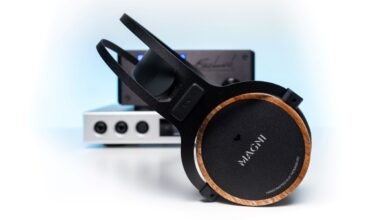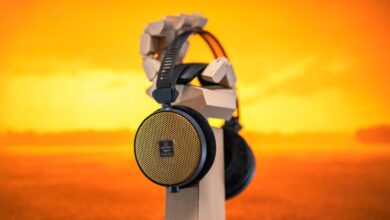Sendy Audio AIVA Review
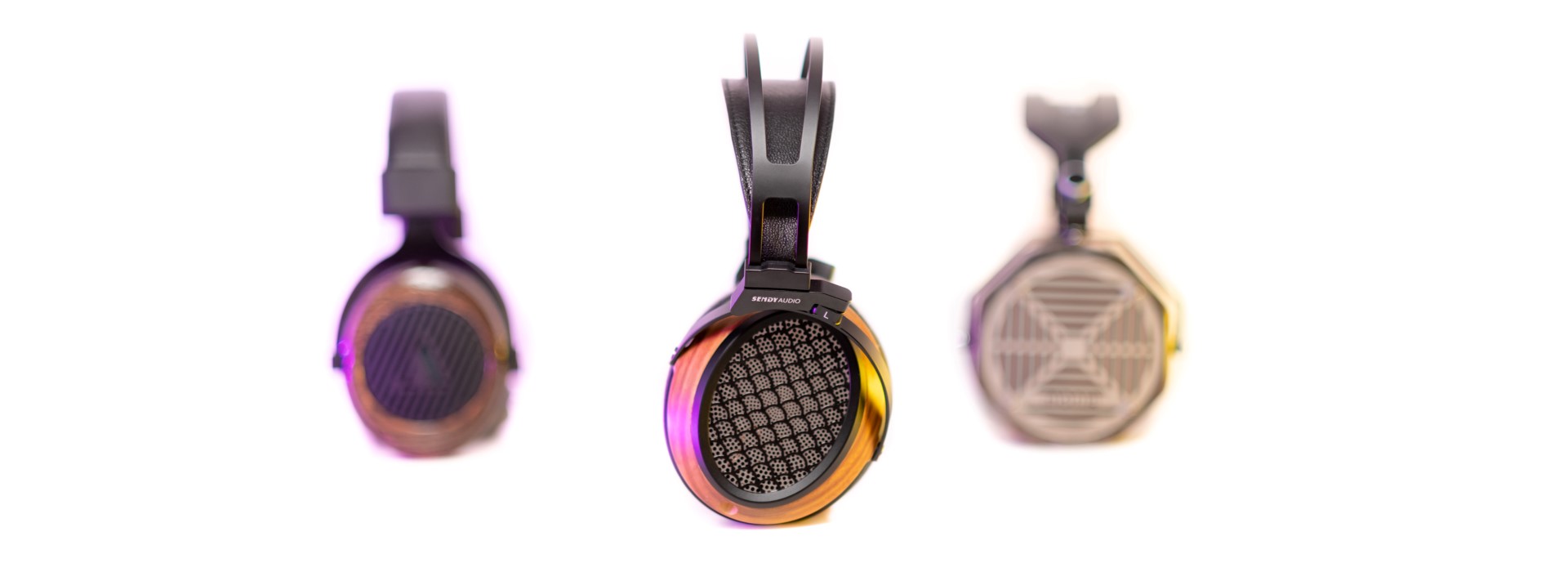
My Video Review:
Sendy Audio might sound like a new headphone company coming from the land of the Red Dragon, except that they aren’t. They are manufacturing headphone drivers for several years now, they are even providing them for various headphone manufacturers. That’s right folks, Sendy Audio might look like a small headphone company, springing up like a mushroom after the rain, but it is very much into audio business for more than a while now. Just several days ago they had only two products in their entire portfolio: a small but cute planar-magnetic in-ear-monitor wrapped in a beautiful wooden enclosure and a full-sized ear-drum kicker by the name of AIVA. Recently, they’ve added a true flagship headphone into their Curriculum Vitae and I wish I would be testing their over-the-top Peacock planar headphone right now, but maybe that’s a story for another day. Today, I will be trying their time-tested AIVA planar-magnetic headphone, forged in the fires of Mount Doom, they appear indestructible and really well put together.
There’s plenty of talk about the Sendy’s AIVA as of late and the more I was reading about them, the more they piqued my interest. Hearing is believing they say and it was only a matter of time when an AIVA would land on my table. I needed to hear them for myself and I’m glad I did. AIVA is priced at $599 and that’s a golden price point, since there aren’t that many headphones in this particular price bracket. Are they worth it though? That’s a powerful question that I’ll try to answer today. Let’s check them out and break it down step by step, in a very customary (read: comprehensive) way.
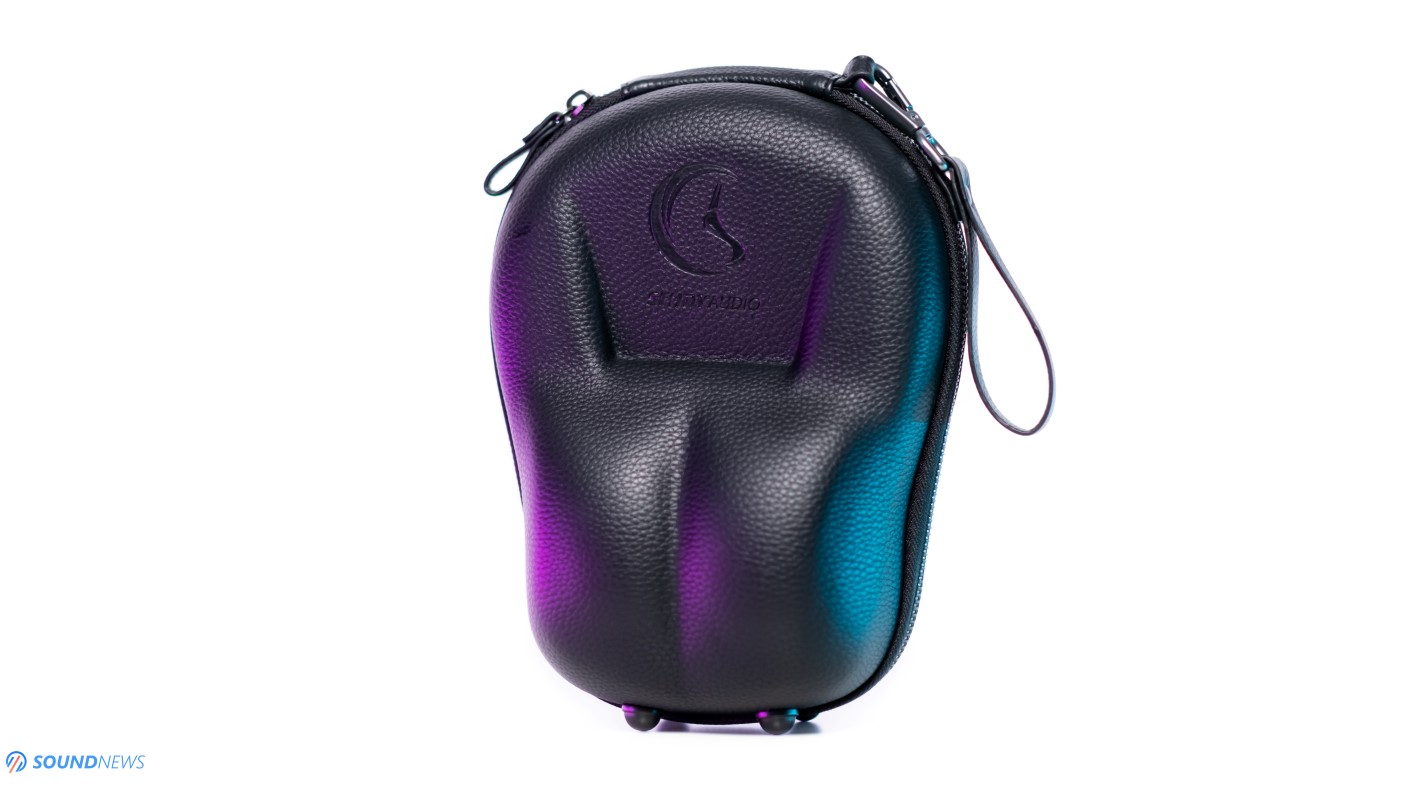
Unboxing Experience
Sendy Audio carefully packaged their creation, double boxed is the standard affair, everything was wrapped with environmentally friendly materials, free of any plastics or other nasty things. A high-quality hard-case is included that has a leathery texture to it. I’m surprised by the quality of this case and by its small form factor. It’s hard on the outside, but soft on the inside, protecting the precious cargo during shipping. After opening the travel case, a fresh aroma of wood and leather hit my nostrils. What a beautiful sight! Their detachable cable is located in a textile pouch and the headphones are standing still in their natural position. The case follows the curve and shape of the headphone structure occupying close to nothing if you are intending of traveling with them. No manuals or additional papers have been included in the package.
The cable quality is impressive, it seems to be hand-made, it uses thick and high-purity (6N) single crystal copper conductors. It has a beautiful wooden splitter, sturdy stainless-steel jacks, terminated with a 4.4mm Pentaconn jack – that is currently my favorite balanced connector. A headphone adapter is also included terminated with a regular 3.5mm jack. The only thing I dislike about this cable and about the headphones are that flimsy 2.5mm jacks that go into the headphones. I don’t have third-party cables with such connectors, so I’ll be sticking with their stock cable for the whole review.
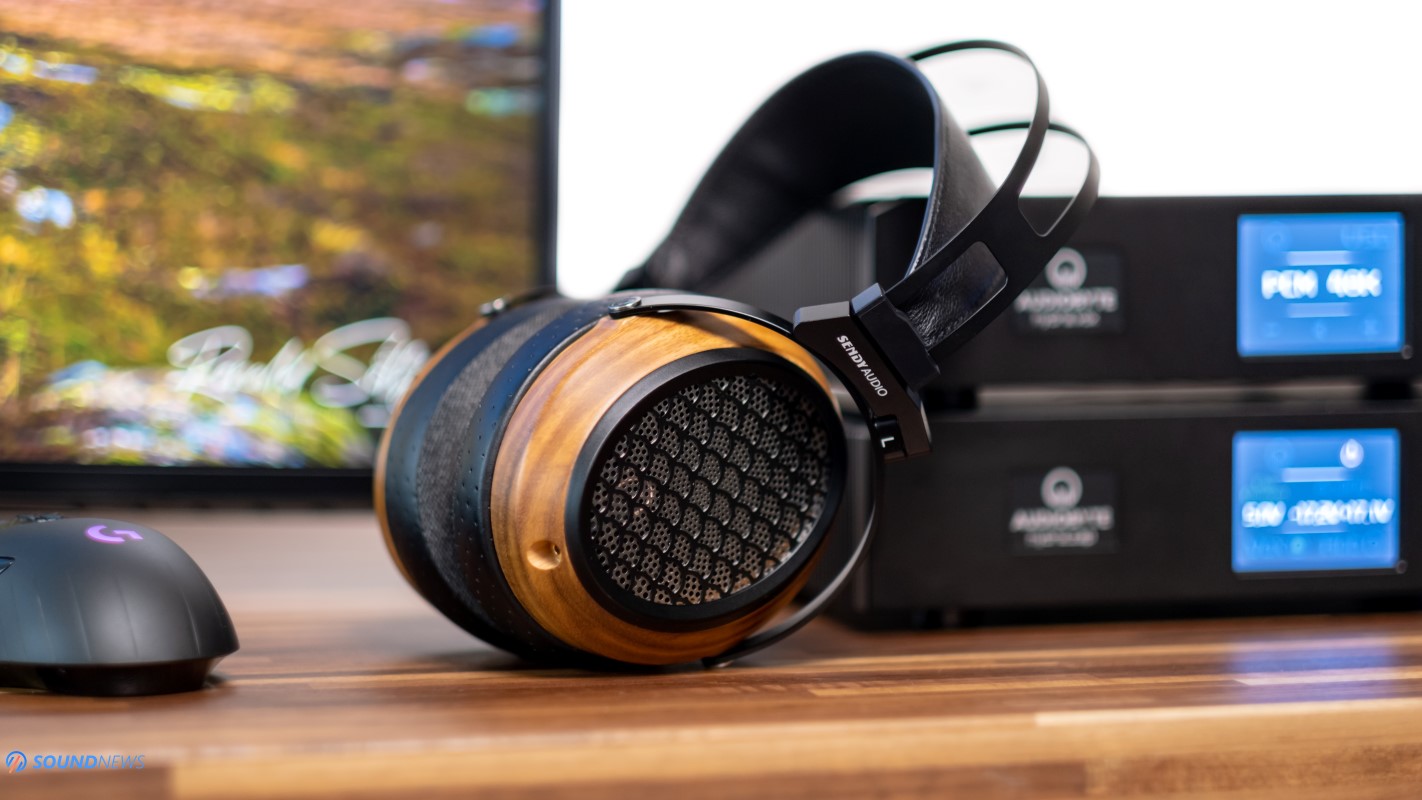
Build Quality & Looks
I wasn’t prepared for such a perfectly balanced headphone, that is extremely comfy to wear and built to high-standards. We are dealing here with a hand-made, open-back planar magnetic headphone that is built by using only long-lasting materials such as aluminum, steel, wood and leather. It has a lightweight but really strong metal frame and no matter where I am looking at, I’m seeing a high-attention to details and a great selection of materials.
Just look at it! It’s sleek, screaming style and good looks, it’s unlike any other headphone I’ve seen on the market. The shape of the cups is very distinctive, their adjustability is spot on, the headband design is quite special, the metal frame looks unique…everything is fresh and new to this particular model. I really dig their sleek looks and if they sound half as good as they look, Sendy Audio got a winner on their hands.
Their ear-cups are made out of zebra-wood – that’s a strong and dense type of wood, plus it offers some excellent acoustic properties. The cups are oval shaped and are reminding a bit about the Apos Caspian headphone that is using similarly shaped cups. AIVA’s steel headband seems to be integrated as a single part throughout a complex process. Its leather headband is very soft and never applies too much pressure on top of my your head. To adjust the headband, you’ll need to gently pull it up or down and that’s it. I’m having a bigger melon and the middle position seems to work just fine for me and there is plenty of travel left. AIVA offers a high comfort for bigger and smaller heads, with little to no side pressure or on top of your head.
Its unusual seeing those oddly shaped ear-pads at first, but after putting them on…everything becomes clear. These are clearly one of the most comfortable ear-pads that I’ve used. Filled with memory-foam, these are quite y soft and are following the shape of my face. They seem to be hugging my ears entirely, offering a good seal, without causing pain or fatigue in long listening sessions.
Last but certainly not least, AIVA weighs only 420 grams and compared to any other mid-level planar headphone, it’s feather weight by comparison. In terms of build quality and material choices there isn’t much to complain, as I find them lightweight and comfortable enough to be used long term.
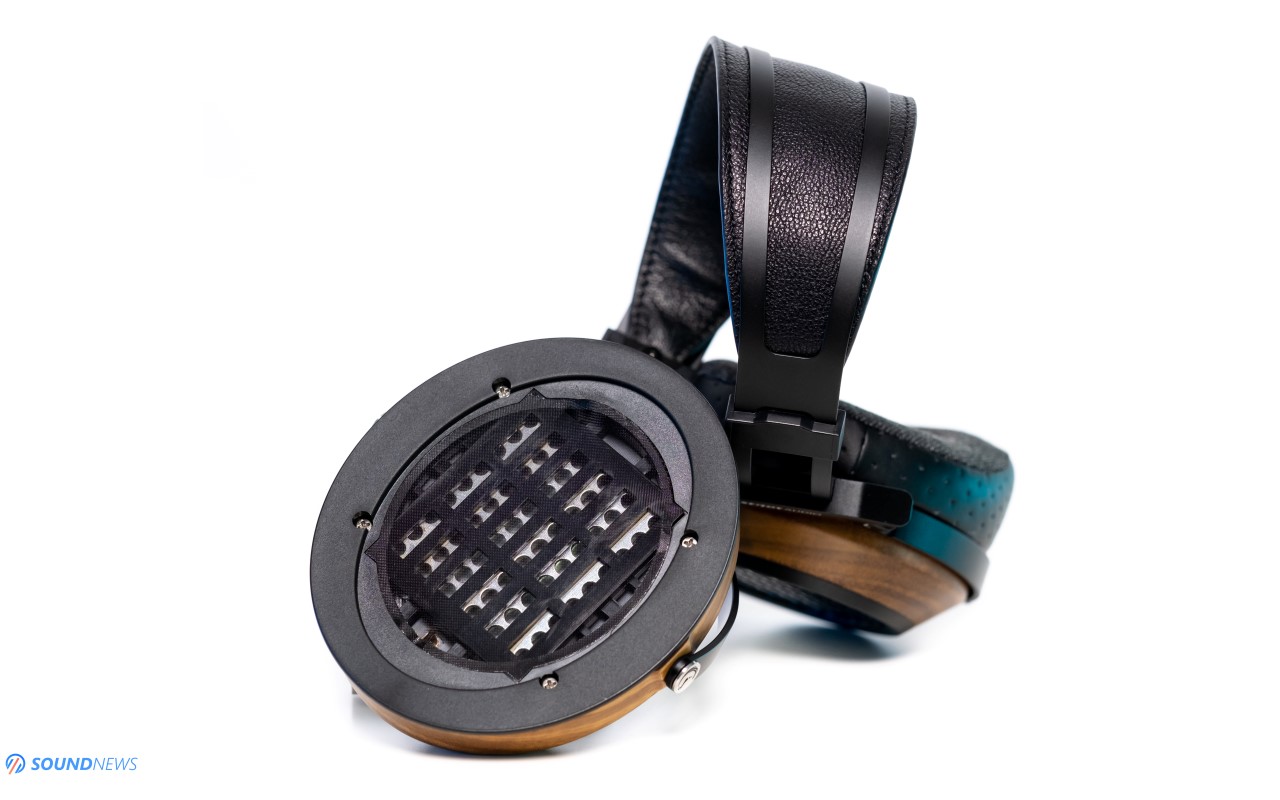
Comfort Level
The ear-pads are deep, soft and are padded with plenty of memory foam. I find them gentle on the cheeks and soft enough to be used in long listening sessions. These are always breathing, so forget about sweaty ears in the summer time. Their pads resemble the stock ones of several Hifiman headphones. They fit around my head snugly and provide enough padding, putting little to no pressure around my ears. In their stock configuration, there was a higher side pressure, but once I’ve adjusted them to my head size, everything went back to normal.
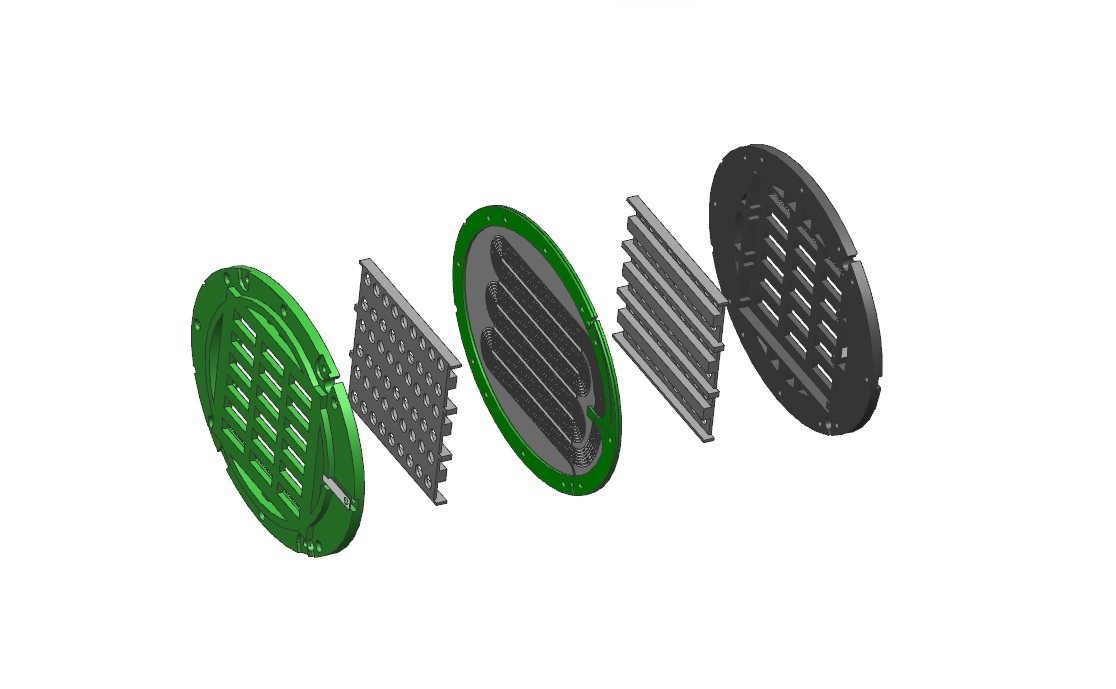
Tech Inside them
AIVA was made from scratch and that took a substantial amount of time to research and develop, more exactly three years and a half. It’s part of their Black Beauty family of headphones and it’s equipped with massive planar magnetic drivers. AIVA is a fully open-back headphone that uses 97 by 76 mm planar drivers. As an open-back headphone, they leak a great deal of noise outside its cups, so it should be used mostly at your listening battle-station.
The thickness of AIVA’s diaphragm sits at only 3 µm and that’s 20 times thinner than the human hair. Its extremely thin that makes them quite fast and impactful when applying a higher magnetic force, plus is should cover the entire frequency response.
Its micrometer diaphragm is driven by a double-sided magnet structure arranged in a push-pull configuration, exactly how most mid to high-end planar-magnetic headphones are running nowadays.
Don’t be misled by its lower impedance of just 32 Ohms, because at 96 dB per 1 mW of power, you’ll need some proper amplifiers to drive these to adequate levels of performance. They need more juice compared to the Kennerton Wodan, GoldPlanar GL2000 and HarmonicDyne Zeus and it seems that a desktop headphone amplifier is mandatory. I will be measuring them in the latest chapters of this review and please make sure to read until the end for a full measurement analysis. Okay everyone, enough with the talk, let’s hit some eardrums!
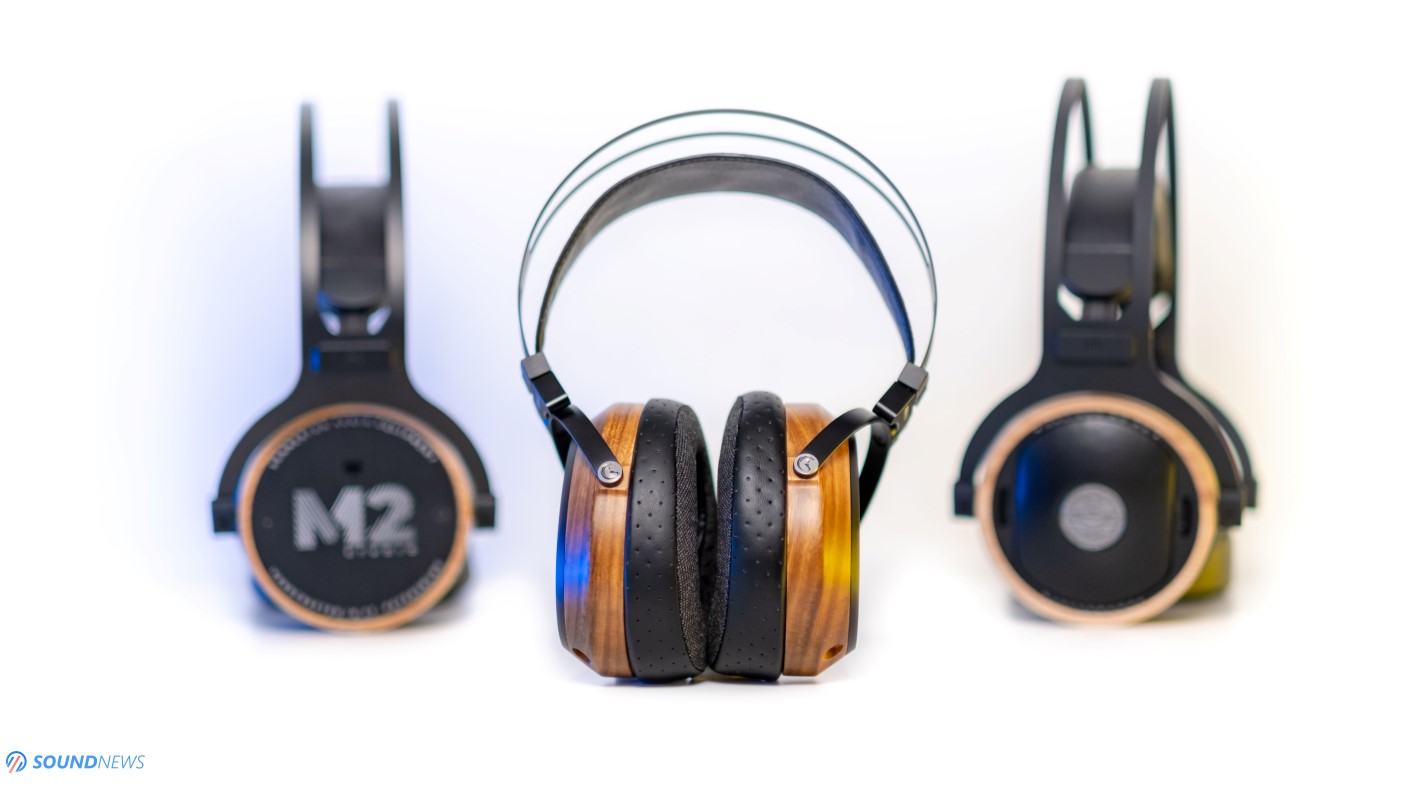
Sound Performance
I. Preliminary Impressions
If you ever wondered what’s the fuss about planar-magnetic headphones, then AIVA seems like a very good starting point, but if you want to be promoted in higher planar-mafia ranks, lock your wallet for good and swallow that key, as much deeper pockets would be required. Some things were done exceptionally well with AIVA and others could be improved upon, but don’t you worry, I will be offering solutions much later on. For starters, there is a very welcome increase in dynamic range and transparency compared to regular dynamic headphones and to entry to mid-level planars. Sendy Audio made them somewhat relaxed in the mid-treble, so you can pair them with pretty much any desktop setup, including with linear and bright sounding ones. AIVA are quite resolving and detail-oriented headphones and if you want to hear all those nuances without too much effort, then AIVA will providing a bit more even compared to pricier offerings like QUAD ERA-1 and Erzetich Mania. Mid-level dynamic headphones couldn’t deliver the same see-through transparency, putting AIVA already in a good lead to its competitors.
With most setups, they will be offering good mid-bass response, a healthy impact into the eardrums, a warmer midrange compared to entry-level Hifiman headphones, but not as much meat to the bone compared to Audeze creations, that are slightly more impressive starting with the sub-bass. There is something cool and less invigorating about its treble rendition, something that could become bothersome in the long run. There is plenty of information past 16 kHz, I find them extended in the treble and very much in line with higher priced headphones, AIVA are even pulling more details from my tunes compared entry to mid-level planars. However, if you are into treble oriented music, you’ll observe that these can get honky, like the sounds are coming from a metal cylinder, adding some unwanted energy to its treble ringing. Its treble rendition reminds me a little about full balanced armature IEMs, there is something…less natural with those and AIVA follows the same path. I’m not about brightness or listening fatigue, but more about its texture and the way it rings and vibrates, adding resonance and echo. Apart from a gentle slope in the sub-bass that could be felt with modern electronica and from a mid-treble roll-off between 2 and 6 kHz, AIVA are almost great when it comes to frequency response. They certainly feel more coherent to the HarmonicDyne Zeus, OLLO S4X and I find them more complete sounding to the QUAD ERA-1.
Sendy’s AIVA are technical sounding headphones, positioning the musical notes at their right places, offering a good layering, a faster pace, decaying the notes at the right time, but not an out of body soundstage level. They sound more like a very good semi-open headphone as far as soundstage goes. It’s decently open and wide, but certainly not over the top, never pushing all those notes far and wide. Luckily, depth and layering are perfectly preserved and with reference or live recordings, you can feel the crowd farther away from the musicians. AIVA is outstanding when it comes to imaging and less so when it comes to soundstage size on all axes.
A big standout for me was hearing them scaling with better performing DACs and headphone amplifiers. They do cost like an entry level planar, but they scaled like a mid-level one. Put them on an R-2R DAC and on a transistor-based Class-A amplifier and forget about everything I’ve said about their honky treble and limited stage size. Rockna Wavelight together with the Flux Volot worked like a magic wand, virtually bypassing all their cons, making them smoother and more impressive in the sub-bass. Same can be said about several tube-based amplifiers that improved their tonality and tamed their treble for good. A setup like that would be increasing the perception of air flying around, making them even more controlled, punchier and ultimately more engaging.
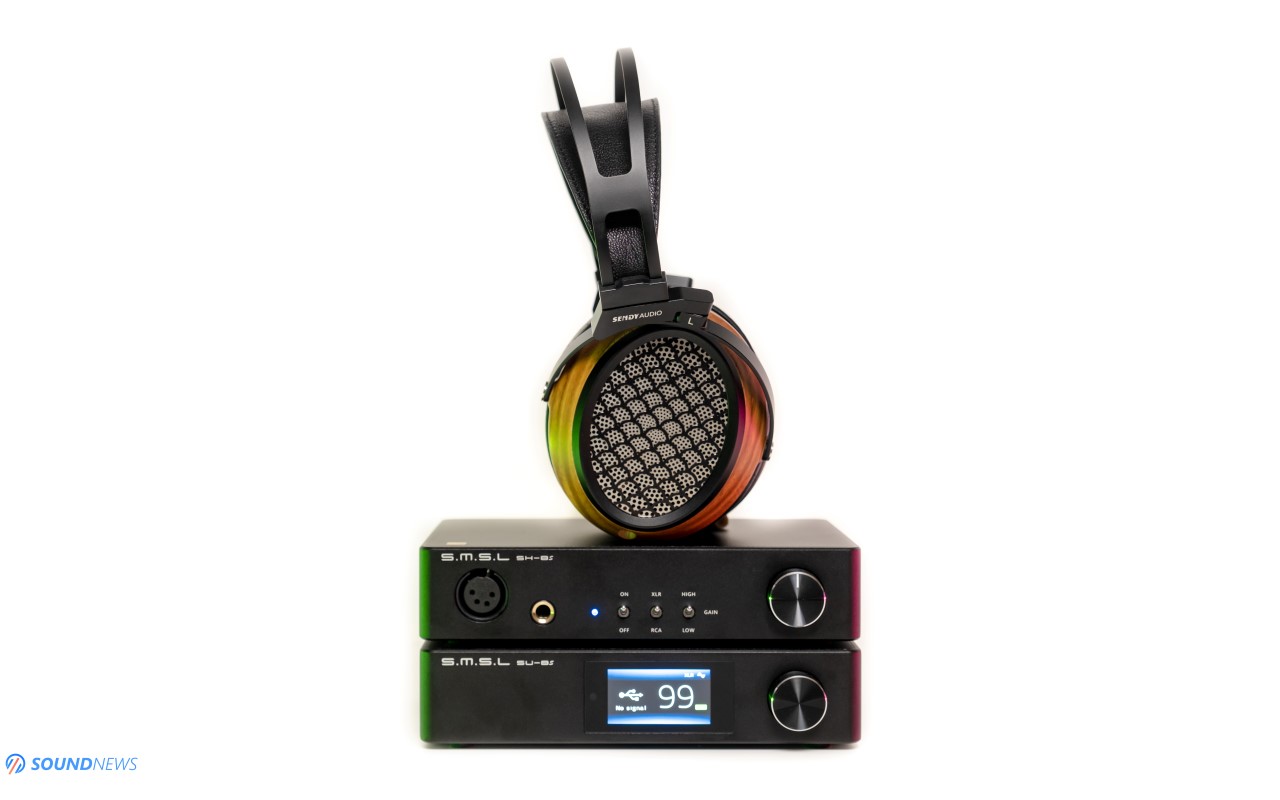
II. Power Requirements & Amp Pairings
AIVA might look like a cozy headphone to wear in long listening sessions, they are comfortable and sweat proof even in summer days, they aren’t that big and heavy compared to top-dog planars, but don’t treat them lightly when it comes to sensitivity and driving power. At 96 dB per 1 mW of power, these aren’t that easy to drive and you should prepare a dedicated desktop setup for the best results, as portable or small USB dongles wouldn’t cut it.
They need as much power as Erzetich Phobos 2021 Edition, Quad ERA-1 and Hifiman HE1000SE and considerably more compared to something like a GoldPlanar GL2000, Kennerton Wodan, HarmonicDyne ZEUS and Fostex TH909. That lower sensitivity makes them less enjoyable and considerably less impactful out of portable devices, so please keep that in mind.
They sounded bad out of my smartphone, laptop and tablet. There wasn’t enough volume and dynamics were completely missing in action. Small dongles like Shanling UA1 didn’t have a chance, only that nicer UA2 sounded above decent. Portable Bluetooth gizmos like FiiO BTR5 and Qudelix 5K were just okay, as again, dynamics felt botched and I didn’t enjoy my music that much if being completely honest with you. I had way better results with portable DAPs like Shanling M6 (21), M6 PRO (21) and FiiO M11 Plus LTD, that finally awoke those drivers from their long hibernation. If you want some better results on the go, then prepare some bigger pockets literally and figuratively, as only bigger portable DAPs and serious DAC/Amps like xDuoo XD-05 BAL and FiiO Q5 TC made them impactful and engaging.
When it comes to desktop power, that cute little Topping A50S and SMSL SU-8S worked well and higher tiered amps like A30 PRO and A90 were more than great. On a very tight budget, I would probably stick with a Topping E30 + L30 setup and call it a day.
I would personally stay away from THX amplifiers, be them from SMSL, Drop, Monoprice or Benchmark, as they weren’t solving their issues and more like amplifying their flaws, especially that metallic treble. As I’ve mentioned before, tube-based amplifiers or Class-A transistor-based amplifiers shined brightly and transformed them in to a better headphone altogether. Singxer SA-1 was particularly impressive, adding more body in the upper midrange and taming the slight treble echo. There is always a hidden desire for power with the AIVA, add some juicy watts in their daily diet and suddenly they become more complete, less bothersome a lot more impactful. By far, the best match was with a 16-Watt Flux Labs Acoustics Volot and FA-10, followed by an 8-Watt Burson Soloist 3X that had an absolute control over their drivers, completely reshaping them into something else. If you want only the best out of them, start saving for a proper Class-A amplifier, that will push AIVA to their limits.

III. Transient Response
This chapter alone is very amp dependent and you shouldn’t worry if someone called them decent in here, while others found them engaging and hard slamming. On a top-tier headphone setup, I find them good when it comes to speed and decay, but I don’t find them utterly amazing when it comes to bass slam, mostly because several dBs from 20 to 40Hz are missing some action and fun. Sure, there is a decent punch in the bass, there is plenty of air traveling down low and I find them above decent when it comes to bass quality. Sadly, the ultimate impact and Mjolnir’s thunderclap couldn’t be felt with the AIVA. For experiences like that, Quad ERA-1 together with the Audeze LCD-2 Classic would work nicer. However, I’m writing about a $599 headphone in here and if I’m taking into consideration all the headphones in this particular price range, then I couldn’t find one that is punchier sounding. Hifiman Sundara and HE400i aren’t that impactful, HarmonicDyne ZEUS is not that thumping and of course dynamic headphones like Sennheiser HD650 will never call down the thunder. Realistically speaking and all things considered including price, Sendy’s AIVA are good in this department and definitely sound like big-driver planar headphones. There is still a decent bass rumble, there’s that physical connection with the low-end, you feel it murmuring and traveling around with bass heavy music, delivered in a clean and undistorted way.
Listening to the latest album of Igorrr – Spirituality and Distortion (Qobuz / Tidal) and to the latest EP by Infected Mushroom – Shroomeez (Qobuz / Tidal) out of a class-A amplifier, checked all my transient response fetishes. I was lightly tapping my feet, smiling and gently hand-banging. Mid-bass felt powerful and impactful sounding, the notes didn’t linger for a micro-second longer, AIVA weren’t pressing the brakes and dynamics were swinging in full force, exactly how a planar-headphone should behave with such music.
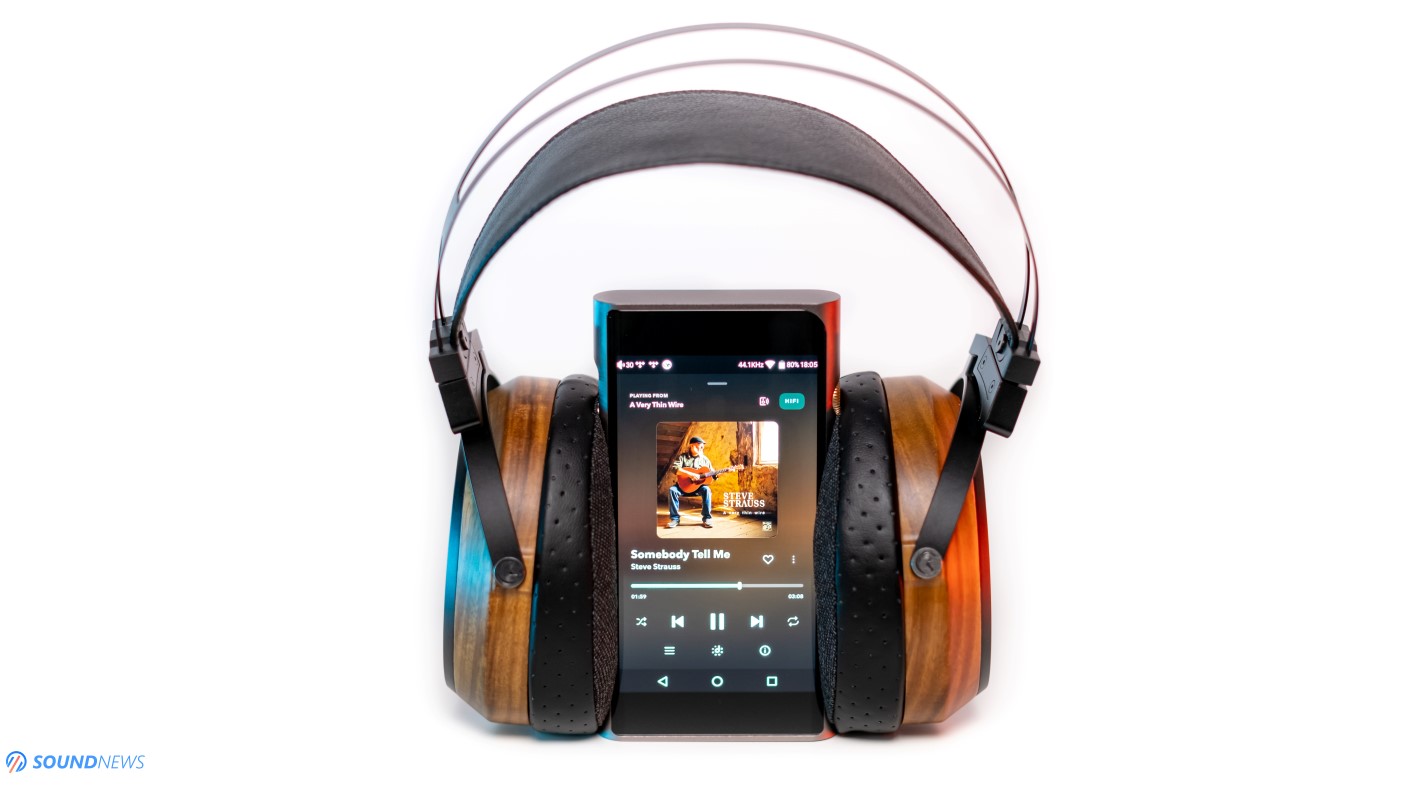
IV. Soundstage & Depth
As an open-back headphone with deeper cushions and bigger ear-cups openings, it is just normal expecting a bigger sound, wrapping you entirely, with music hovering somewhere outside your head, you expect those notes going past your shoulder level, picking musical notes out of thin air like butterflies…and that is certainly the case with AIVA, but to a smaller degree. While putting my hands on those ear-cups, I feel their tonality changing, hurting their soundstaging capabilities, but there isn’t such a radical change as it is with Hifiman open-back headphones. After digesting several live albums, AIVA appeared as only decent in here, adding a fair amount of air between the notes, but not as much as I’m usually expecting out of open-back planars…and that’s perfectly fine. Not every single individual enjoys an out of head experience and an open wide soundstage. They reminded me about semi-open headphones like OLLO S4X and HarmonicDyne Zeus, as it goes into the same direction. Soundstage doesn’t feel particularly wide and isn’t thrown that far away from the listener, so expect a smaller and cozier music playback. Still, you’ll find them slightly bigger sounding to the HD6XX family of headphones by Sennheiser, bigger to the Audeze LCD-1 and OLLO’s S4X.
In its defense, I will mention that depth felt considerably better, it is actually one of its main strengths. If you close your eyes, you can easier follow a musician, you can feel the distance between you and any musical note flying in the distance, creating a precise 3D map of the track that is being played. Some notes appeared closer, some much farther away and AIVA was never bi-dimensional how I find several Grado headphones. Imaging was spot on and so was the pin point location of all the notes.
As a side note, if you really can’t stand up-front and crowded presentations, a transistor-based or a tube-based amplifier would be increasing the air delivery on all axes. Overall, I find them great when it comes to layering, depth and imaging and less impressive when it comes to stage size.
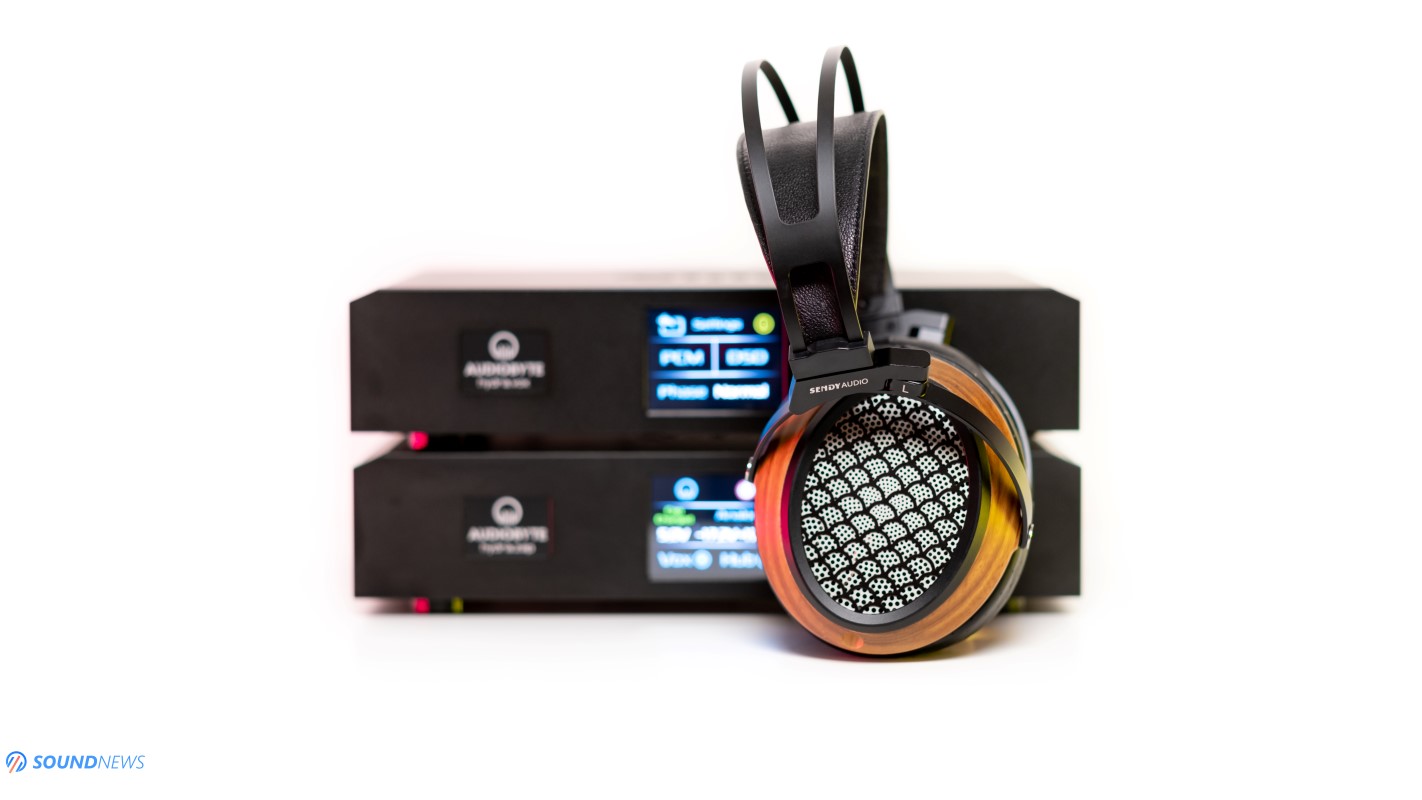
V. Detail Retrieval & Transparency
I dislike distortion and weaker dynamics, but what I dislike the most is a lack of transparency and detail-retrieval. That’s my biggest fear and my number one reason I’m sticking with a Benchmark HPA4 being driven by top-class D/A converters. I can’t stand muddiness; a lack of resolution and I’m not enjoying my time when I can’t hear the smallest nuances. No wonder you no longer see HD650 or LCD-2 hanging on my wall…
Finally, I’ve arrived at the culmination of what makes AIVA a good headphone in the first place. No matter the track or the headphone setup, they always wanted to impress me with their cleanness, unearthing a higher degree of details from my tunes and it’s so refreshing hearing them pop in the most unusual places. What’s really interesting is that AIVA retains sparkle and detail even at much lower volumes and try doing that with a pair of HD650. When I say detail, by no means I’m addressing to its treble range only, as there is extra information in the low-end and midrange sections. I find Sendy Audio’s creation detail-oriented, working as a microscope for your beloved tracks. The amount of detail coming out felt directly tied to the headphone setup that was connected to them and they scaled amazingly well in this department. Go higher and they will be responding back, go even higher and AIVA will be surpassing pricier headphones, even reaching several headphones in the $1000 price range.
In this regard, AIVA sounded more resolving to pricier headphones as Quad ERA-1 ($799), Audeze LCD-2 ($995) and Erzetich Mania (€1200). Sennheiser HD650 and lower-tiered headphones like Meze 99 Classics never stood a chance, whipping clean a layer of information out of existence compared to the AIVA. If detail retrieval is important and you want the most transparent sound for your hard-earned money, then there are two options for you: Sticking with the AIVA or choosing any of the entry level Hifiman planars.
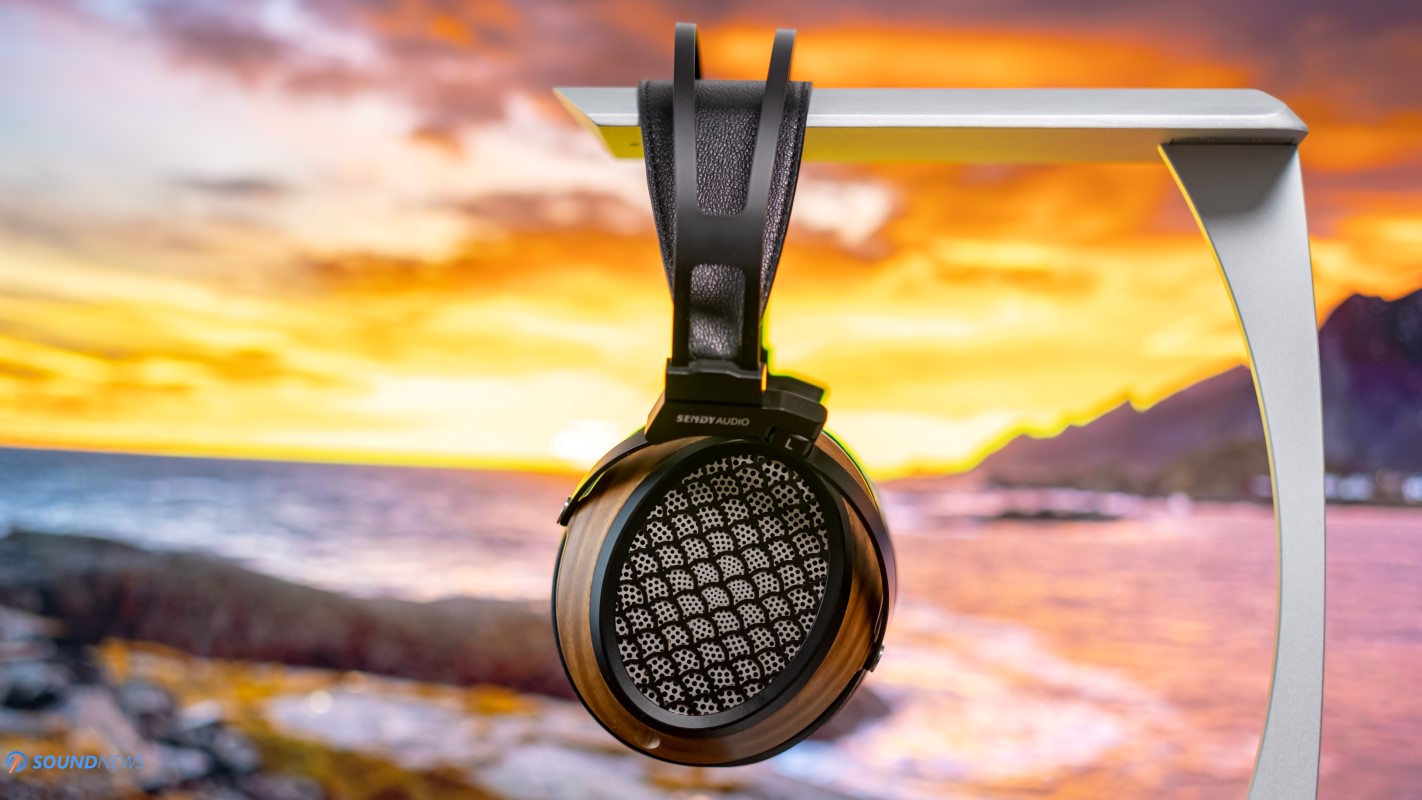
VI. Frequency Response
A. Bass
Planar magnetic headphones are notorious for delivering excellent performance in terms of bass quantity and quality, unsurprisingly AIVA isn’t an exception from that rule. Connect them to a desktop headamp and they will impress you right away with a clean, detailed and layered bottom end. Sub-bass felt recessed by a little, there is a gentle slope between 20 and 50 Hz, but that isn’t something worrisome. Most probably their heavily perforated ear-pads are causing this, but I can’t test my claims as I can’t try different ear-pads on them due to their shape. The driver itself can take it no problem as when I’m gentle squeezing them against my ear, all that sub-bass energy comes back to life, so I’m pretty sure a full-leather earpad would sound nicer in the low-end. Going past 50 Hz, it becomes a lot more linear, much more defined and powerful. You’ll find a highly technical and enjoyable mid-bass section and that’s one of the best parts of Sendy’s AIVA. Mid-bass felt elevated by a little, adding warmth, richness, lots of weight and rumble and that is the sound that I like.
B. Midrange
AIVA offers a linear and a straight as a line midrange performance. It starts very strong and it is maintained up until 1 kHz where it gently starts going down. Midrange comes in right doses, it’s slightly fuller sounding to a Hifiman Sundara, but less so to an Audeze LCD-2. You’ll find a technical midrange, with traces of warmth and fullness. As a side note, I find them more enjoyable to a HarmonicDyne Zeus that sliced and diced a big portion of the upper-midrange, but luckily that isn’t happening with the AIVA. I find them rich sounding, especially out of transistor-based amplifiers and R-2R sources and just mildly smooth out of any other setup. Vocal performance seems to be great, voices never sounded nasal or shouty and they always had a natural decay. The pitch of the human voice wasn’t perfect as female voices weren’t that soul-grabbing to me, losing some definition in the process. Upper-midrange starts its descent at around 1.5 kHz making female voices less present in my tunes. In my view, Sendy Audio went with a safe tuning, adding just a right amount of warmth in the midrange, without putting an accent on sibilant overtones.
C. Treble
I find them pleasant and unoffensive when it comes to treble rendition. Why? AIVA aren’t elevating the treble response even by a single decibel. At best, it’s exactly on the same level with the rest of the FR and at worst it goes down by a few dB. In simple terms, it means that you can completely discard notions as brightness and listening fatigue. These don’t make your trebles hot and they never make you lower the volume when drumsticks are touching down on cymbals. There is plenty of detail up top, I find quite extended in there and gentle enough for aggressive and treble intensive music.
However, there is one issue that I’ve mentioned earlier and it has to do with its construction and probably not with the driver itself. Sometimes, there is a slight echo in the treble, like some sounds are bouncing off a metallic cylinder. If you ever experienced treble oriented balanced armature IEMs, it is very much the same. However, this effect doesn’t come to the surface that often, it appears with linear headphone setups and only with treble intensive music.
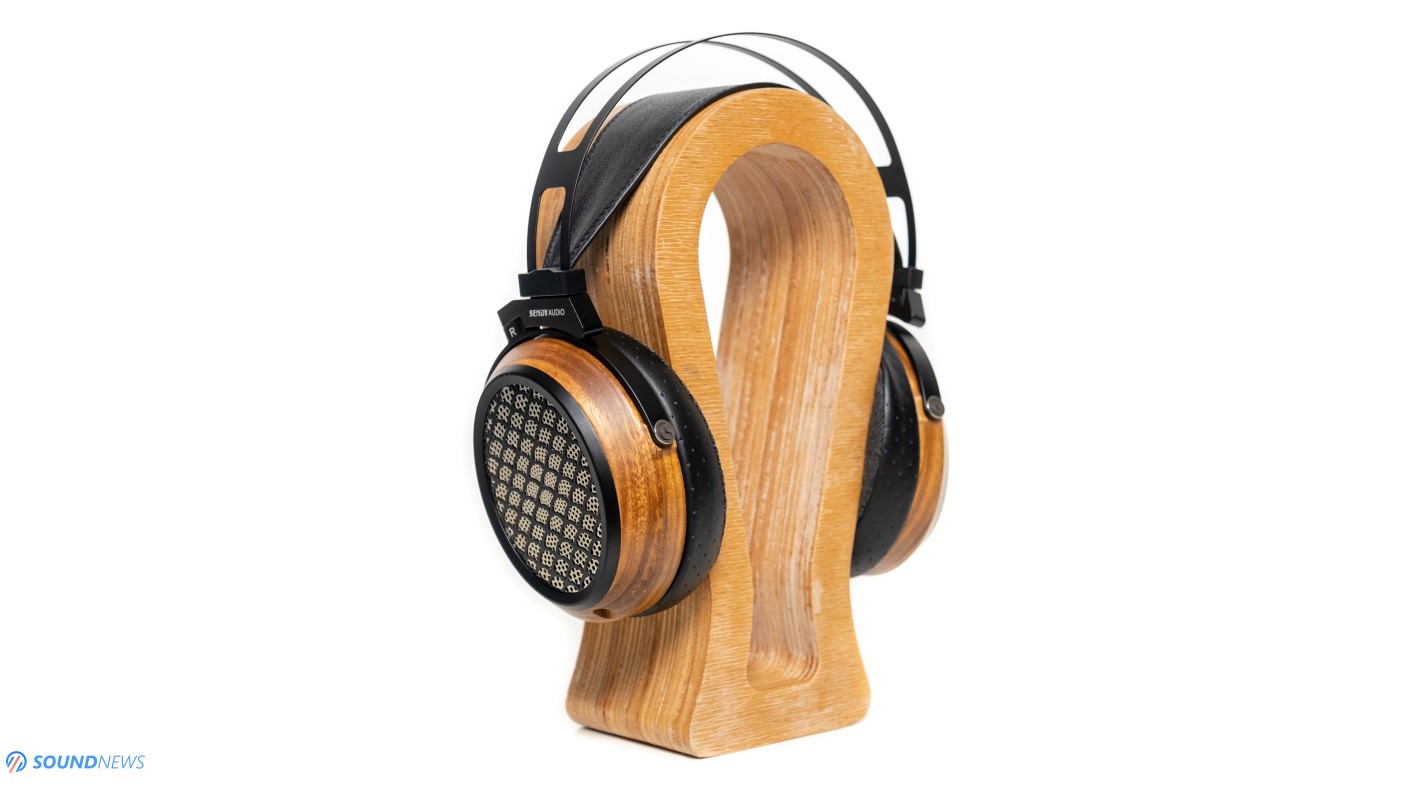
VII. Measurements
After offering my subjective opinion, it is time putting them under a magnifying glass seeing how they really perform. When it comes to measurements, I have the highest confidence in the Benchmark HPA4 as it is as linear as headphone amplifiers could ever be and I have resumed at using the Matrix Audio Element X as the main DAC for the job. The measurement rig used was the MiniDSP E.A.R.S. calibrated with HPN (Original Headphone Compensation) files. Do note that MiniDSP E.A.R.S. is not following any IEC standards, meaning that my readings can’t be used as reference measurements or anything like that, I’m doing them only to get a general idea about their sound signature.
I have measured them several times, as finding the perfect spot on the test jig wasn’t that easy due to their unevenly shaped ear-pads. No side-pressure was applied on the earcups, they stood still in their natural position.
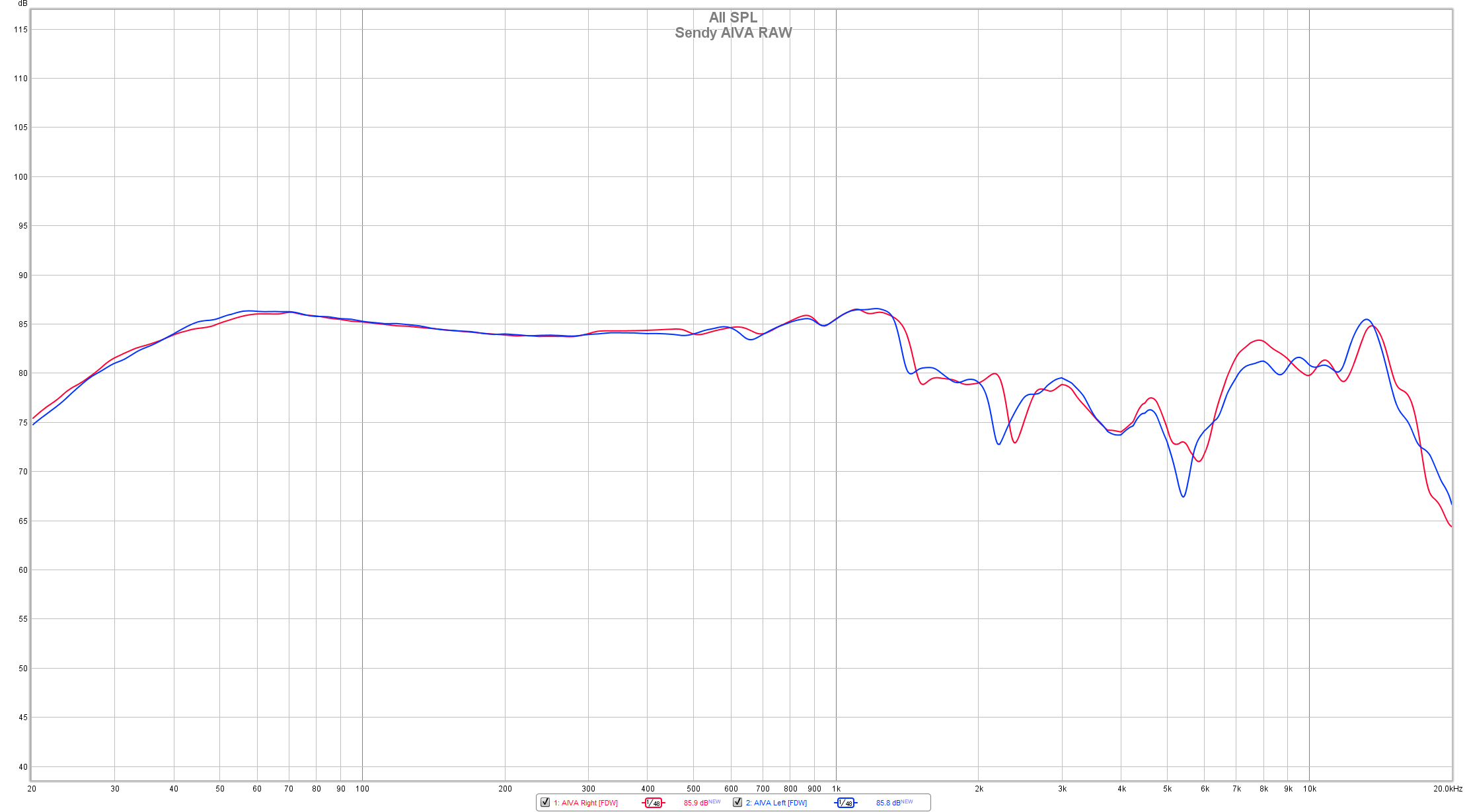
Take a look at their RAW measurements without any smoothing applied. The first thing you’ll notice is that the drivers aren’t matched very well past 2 kHz. I measured them about 15 times and every single time I’ve got the same result. At best both channels will be offering the same SPL and at worst there is a 5 dB difference somewhere between 2 and 3 kHz.
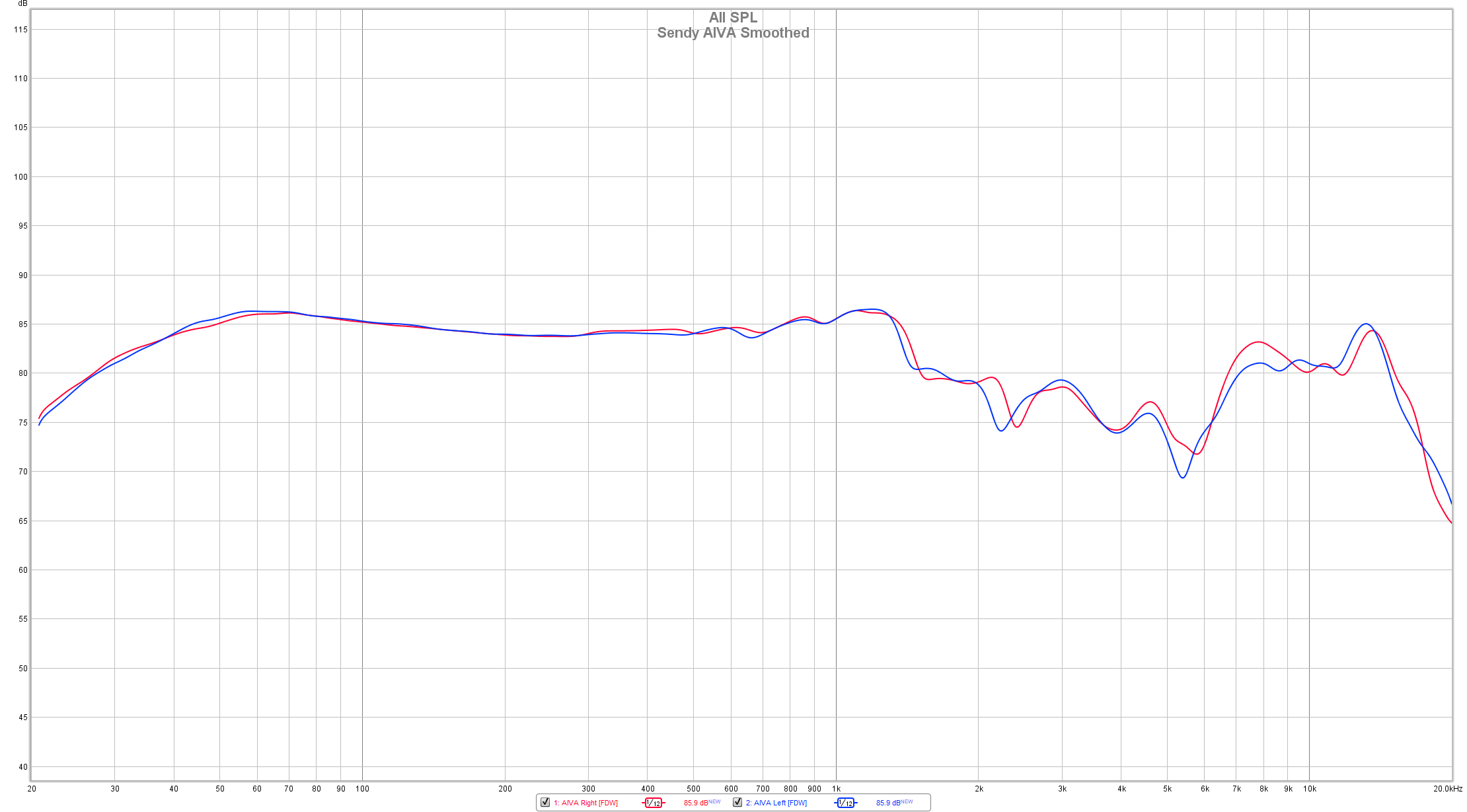
After applying a gentle 1/12 smoothing, things remained more or less the same. You can certainly see the gentle roll-off I was mentioning in the sub-bass region and there is another one happening between 1 and 6 kHz and scares the brightness away. The treble roll-off isn’t bothering at all, but the one in the upper midrange is making female voices less believable, taking away some magic.

A Total Harmonic Distortion (THD) of 0.4% is more than good, but it seems that AIVA aren’t controlling their drivers that well between 20 and 70 Hz. You can see a substantial increase in the THD, even reaching 10% at some point.
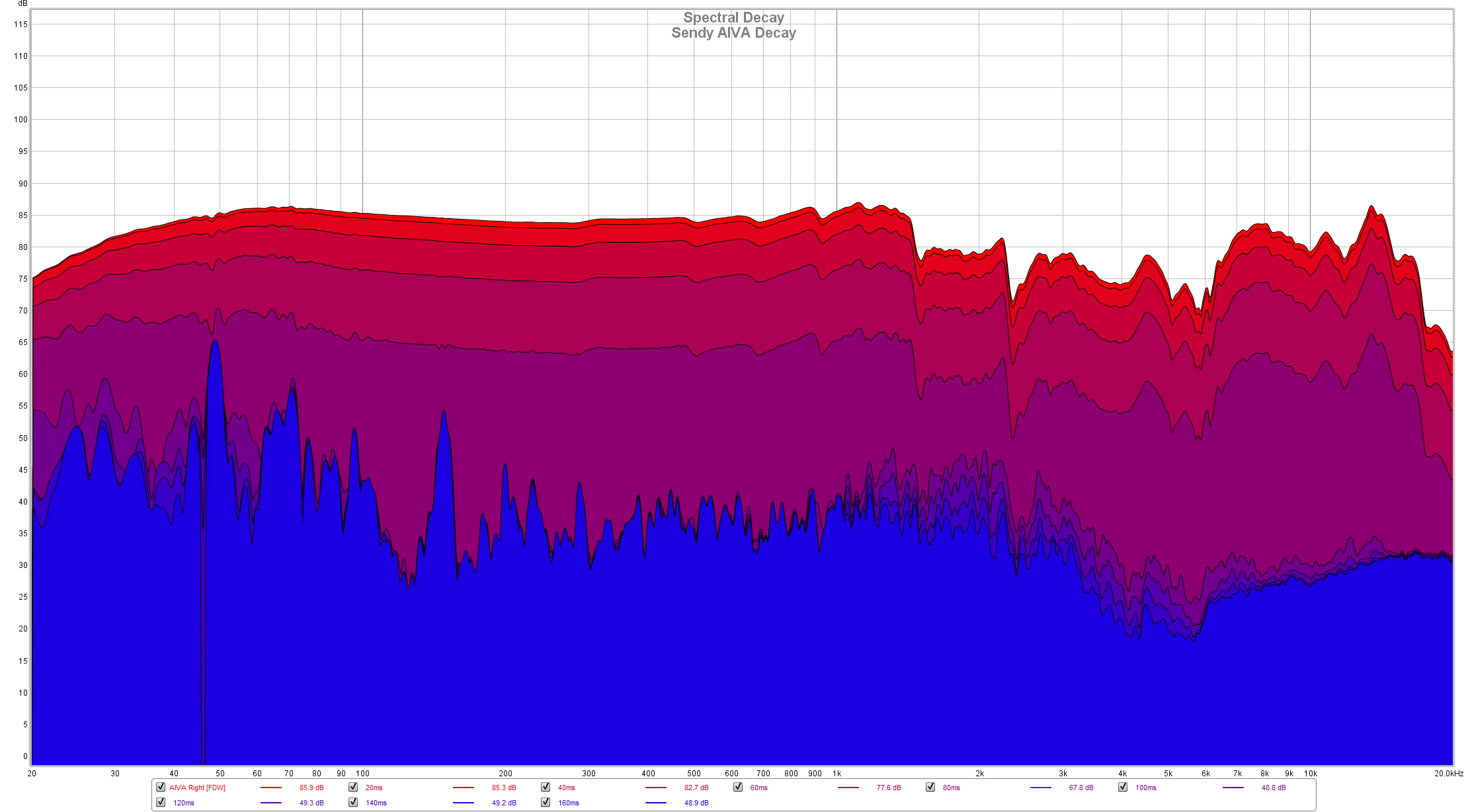
Decay of the notes seems to be good, but not exceptional. After sending an 84 dB Sine-Wave, 160ms later the sound intensity lowers to 48.9 dB. Usually, planar headphones are staying somewhere between 30 to 40 dB (much lower), suggesting that AIVA aren’t extremely fast sounding and in this regard are mimicking the sound of dynamic headphones.
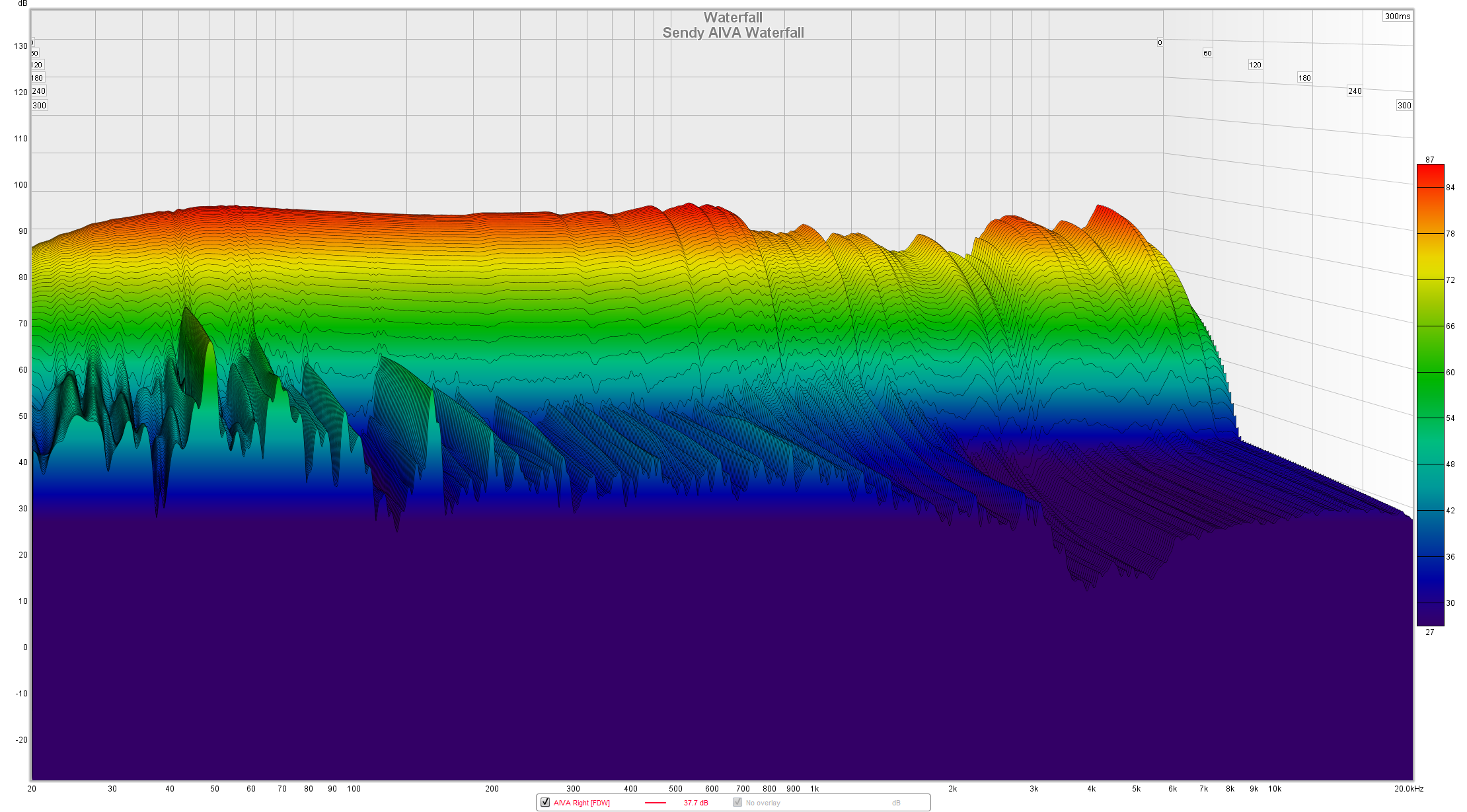
Waterfall combines the FR plot and decay into a single graph and you can clearly see the hot spots in the FR and the slower driver movements in the bass.
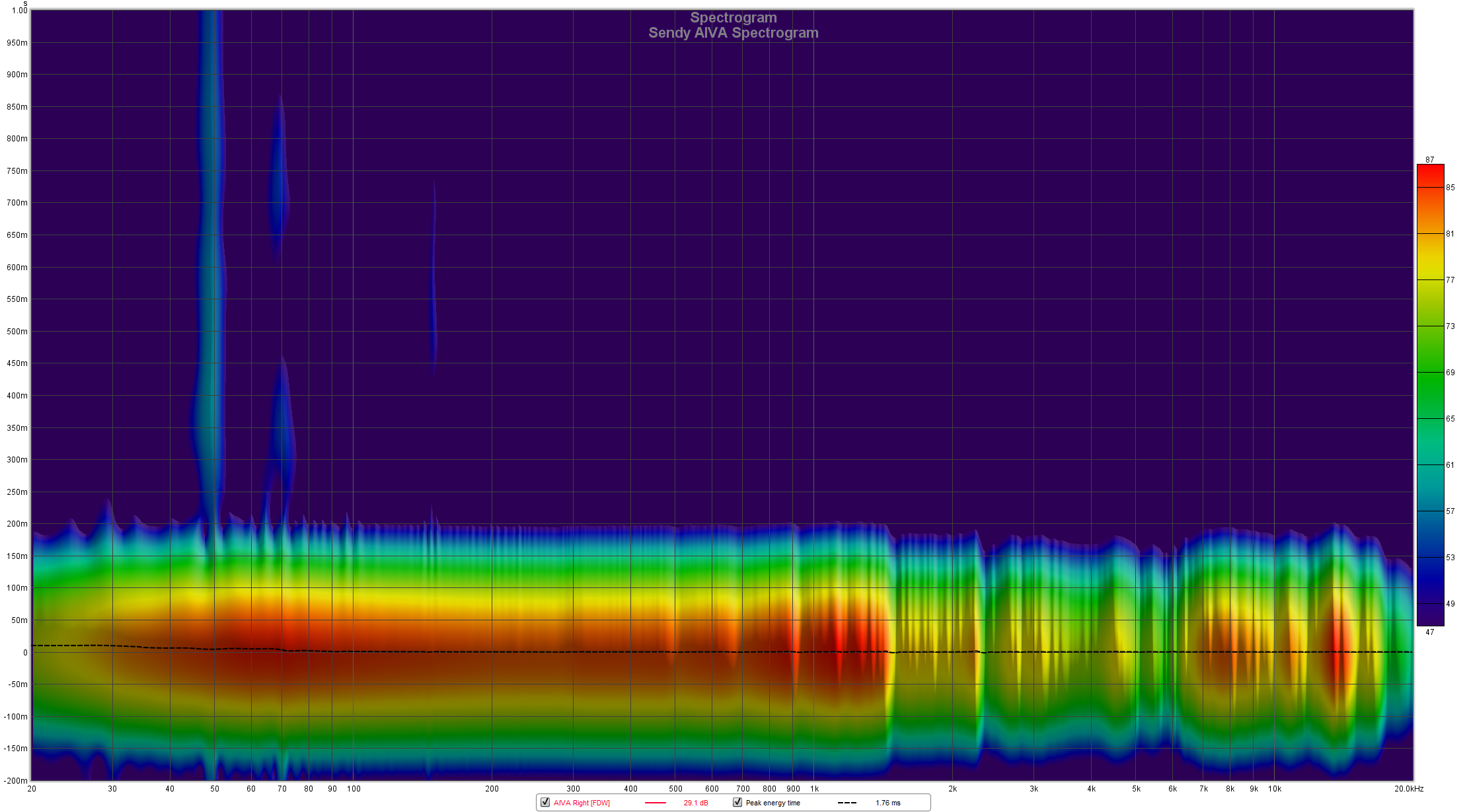
Spectrogram shows some minor ringing happening at 50, 70 and then ~150 Hz, suggesting that indeed there is some unwanted resonance in the bass, that added a bit to the THD reading.
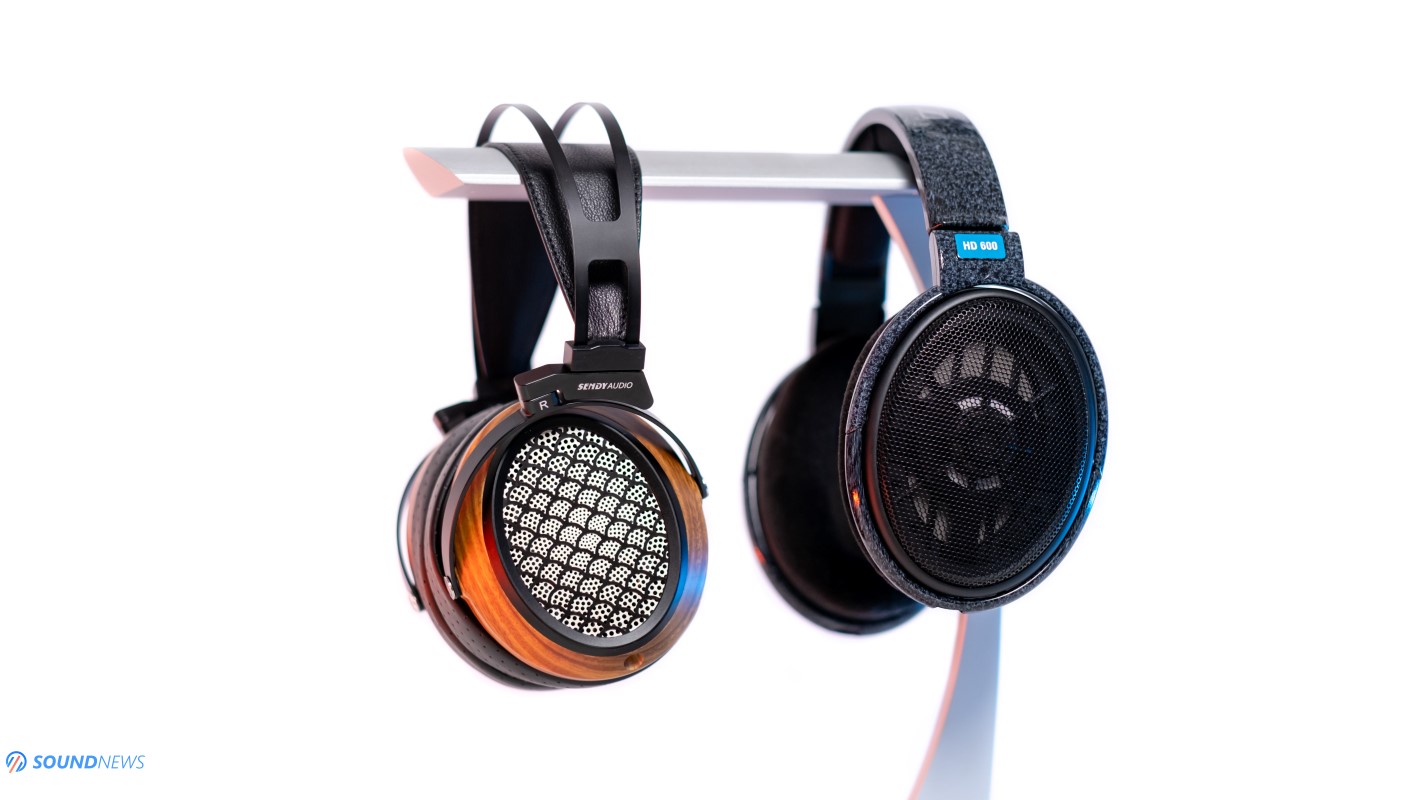
VIII. A Comparison
Sendy Audio AIVA ($600) VS Sennheiser HD600 Newest Revision ($400)
When it comes to design, material choices and build quality, there isn’t even a contest, as AIVA just oozes style and good looks. Everything feels at a much higher level and I find them comfier. We are talking about a full steel frame supporting zebra-wood cups that are covered with plushy ear-pads. HD600 are way too plasticky, with a less impressive frame and sturdiness. HD600 looks and feels cheaper, while AIVA radiates authenticity and great styling. AIVA just won its first point.
When it comes to comfort, in their stock form (without bending the HD600 headband) Sennheiser cans are losing this game. HD600 have a higher clamping force and there is more pressure on top of my head. AIVA provide a higher degree of adjustability, they can work with bigger heads and they don’t clamp as much, offering little to no pressure on top of my head. I can wear them for a few hours, maybe for half a day, while HD600 are becoming bothersome after an hour or so. AIVA are scoring another point.
When it comes to packaging and bundled accessories, you are getting a very basic rubberized cable and a card-board display case with HD600, while Sendy Audio offers a custom-grade high-purity 4.4mm balanced cable, that is thicker, uses higher quality conductors and connectors. A headphone adapter can also be found in there. On top of that, you are getting a fully functional travel case and that’s why AIVA are scoring another point.
When it comes to sensitivity, there is a very small difference between them. Benchmark HPA4 together with MiniDSP EARS recorded a difference of 0.5 dB between them models and what was 85dB on AIVA, resulted in 85.5 dB SPL on HD600. Both headphones are requiring a dedicated headphone amplifier, but since Sennheisers are slightly easier to drive, HD600 are scoring their first point.
In terms of technicalities, immediately you can feel that AIVA are playing in a higher league when it comes to transparency and detail retrieval. There is just more happening at lower and higher volumes, as they are pulling more nuances from my music at all times. With HD600…it is like listening to music through a pillow, I feel that something is staying between me and my music. The notorious Sennheiser veil couldn’t be bypassed even by high-end DACs and headphone amplifiers and no matter what I’d do, AIVA just sounded clearer and considerably more precise. The whole frequency response felt fuller, as I was hearing more information at both frequency extremes. AIVA are easily scoring another winning point.
When it comes to sound staging capabilities, there is little to no difference at all. Both are sounding more or less the same, but when crowded music came to play, there would be more layers of music with the AIVA. Music felt deeper with the AIVA and a few sounds were playing at a higher altitude. HD600 felt bi-dimensional at times, plain and simple these were never wide or tall. At best, HD600 were on the same level with AIVA and at worst slightly cramped and closed-in. It was a fierce round, but AIVA outmatched their competitor once again.
When it comes to frequency response, HD600 feels more linear and nothing is standing out too much, but they’re slightly reserved then it comes to fun factor, I find them enjoyable only out of several headphone setups. AIVA is more playful and slightly more vivid sounding to me. AIVA’s boosted mid-bass makes them stand-out with modern impactful music. There is more happening in the low-end and upper treble with the AIVA, hence winning another round.
While AIVA delivers a nicer upper treble performance, HD600 offers more information in the lower treble. I can spot that information much easier and the most sensitive part of our hearing shines brighter with the HD600 and that’s why I’m going to give another point to the HD600.
AIVA are more fun, they sound faster and snappier and HD600 aren’t that impressive in this department. I don’t enjoy them as much with my electronica tunes, as I am enjoying the AIVA. I could better feel the impact of every musical note with the later, while HD600 felt gentler and much easier on the ear. Both can sound slow, smooth and mellow, but only one can push higher dopamine in the blood-stream. AIVA knocks out its adversary and wins another point.
Both headphones are going towards the same tonality, but HD600 are always rounding the frequency response, cutting clean portions of the sub-bass and upper-treble. With AIVA, you are definitely experiencing a much wider FR, much closer to a reference sound that wants to put everything on a plate. They both go with a warmer and smoother tonality, but AIVA is just more impressive in terms of technicalities. However, you can relax and detach yourself much easier with the HD600, these are always gentle with the listener. HD600 might work nicer with Blues and Jazz. It looks like we have a draw.
In the end, Sennheiser HD600 scored 3 points, while Sendy’s creation outmatched them with 7 points. HD600 is still a classic among headphone enthusiast and they still have a very unique character and tonality, but AIVA seem to play at a higher level with almost everything that hops into my playlist. Considering that both are going for a similar tonality, AIVA could be seen as a potential upgrade and as your first ticket into planar-mafia territory. Come over, we have cookies!
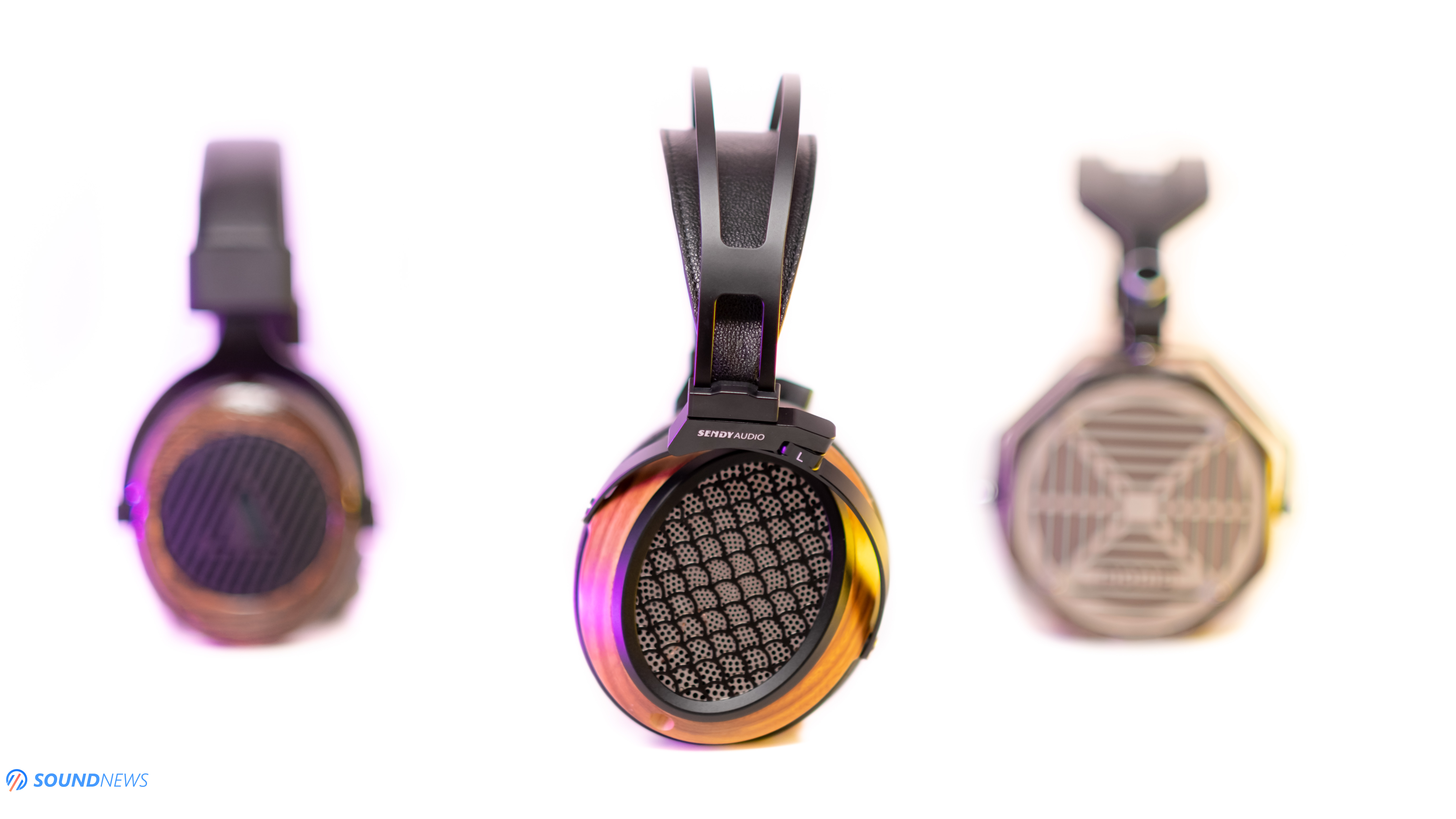
Conclusion
Sure enough, there were some drawbacks like a limited soundstage size, a less than perfect driver matching, a higher THD and some deviations in the frequency response, but everything else performed at a pretty high level.
Sendy Audio crafted this headphone in such a way, that you can put them on, close your eyes and completely disconnect from the outside world. Its warmer tonality, great mid-bass and midrange sections made them stand-out from all other mid-level planar magnetic headphones. Their gentle and unoffensive treble, makes them great sounding out of almost anything. There is a bit of echo in the mid-treble, but you can easily tame that energy with transistor-based and tube amplifiers or with a simple EQ curve. After experiencing impressive levels of details at much lower volumes, I can focus on my work and still listen to all the newest albums, something that not a lot of planar-magnetics can offer nowadays. AIVA aren’t stealing your attention with their relaxed, easy-going tuning, but they will be surely turning heads thanks to their eccentric look and beautiful design. There isn’t a headphone that looks as quirky as Sendy Audio’s AIVA. Their lower clamping force, soft-pads and rudimentary head-band slider, makes them comfortable to wear and pleasant to look at. For $599, these are offering a lot in return and it wouldn’t be fair without awarding them for that. All things considered, AIVA fully-deserves our Bronze Award.

AIVA was kindly provided by Sendy Audio and it can be purchased from their world-wide distributors right here.
PROS:
- Cool packaging, love the hard travel case
- Stock cable quality is way above average, plus it’s fully balanced!
- A unique looking headphone, they are certainly eye-popping
- Great build-quality and material choices
- Comfortable in the long listening sessions, lightweight frame
- Full-bodied tonality, works outstanding with any headphone setup
- Precise imaging and an impressive depth
- Delivers a natural decay of the notes, could be speedy at times
- Outstanding levels of detail-retrieval, especially for the price
- Good dynamics
- Extended in the upper-treble
- Great technicalities for the buck
CONS:
- Limited soundstage size
- Not the hardest slamming bass
- Questionable measurements
- Need a dedicated amp to shine brightly
ASSOCIATED EQUIPMENT:
- DACs: Rockna Wavelight, Audiobyte HydraVox & HydraZap, Musician Aquarius, Matrix Audio Element X, Gold Note DS-10 Plus & PSU-10 Evo, Gustard X26 PRO, X16, Topping D90SE, SMSL D1SE
- DAPs: FiiO M11 Plus LTD, M15, Shanling M8, M6 (21), M3X
- Headphone Amps: Benchmark HPA4, Singxer SA-1, Flux Lab Acoustics Volot, FA-10, Burson Soloist 3X, Musician Andromeda, SMSL SP400, Topping A90, Gustard H16 & others
- Preamps: Benchmark HPA4, Topping PRE90
- Power Amps: Benchmark AHB2 in bridged mode (x2), KECES S300, SMSL SA400
- Loudspeakers: KEF Reference 3, Natural Sound NS-17
- IEMs: FiiO FA9, FH7, FH5S, FD5, Meze Rai Penta, Rai Solo, LittleDot Cu KIS, Hiby Crystal 6 & others
- Portable headphones: Sennheiser Momentum 2, Meze 99 Classics
- Full-sized headphones: Sendy Audio AIVA, Apos Caspian, Hifiman Susvara, HE1000SE, Arya, HE400SE, Audeze LCD-4, Erzetich Phobos, Erzetich Mania, Kennerton Wodan, Magni, Gjallarhorn, Vali, M12S, Ollo S4X Reference & others
- Interconnects: QED Reference (x2), Topping TCX1 (x2)
- Speaker cables: Kimber PR8, Audioquest Type4
- Power Cables: Isotek EVO3 Premier (x3)
- Balanced Isolation Power Conditioners: PLiXiR Elite BAC1500, Elite BAC400




